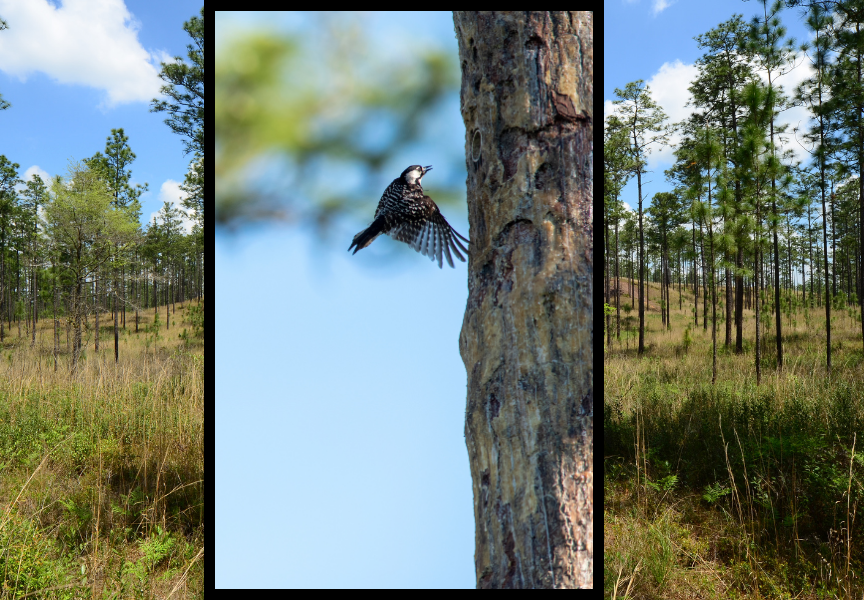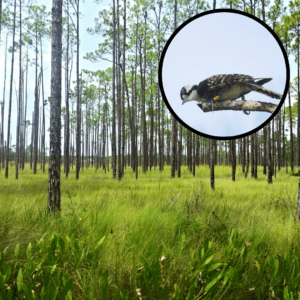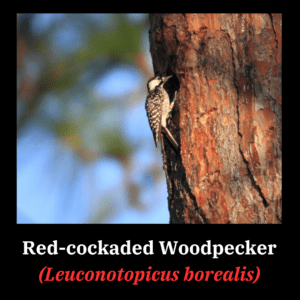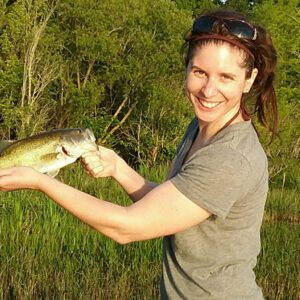Hope for a Species: NCWF’s Work Protecting and Conserving Red-cockaded Woodpeckers and Longleaf Pine Habitat

Wild songbirds and butterflies flitted amongst blades of native grasses blown by a southern breeze. Fox squirrels, white-tailed deer, and wild turkeys passed silently among the ranks of longleaf pine trunks standing resolutely beneath heavy crowns of emerald green.
And high above, just beneath the overstory… a flicker of black, white, and red – followed by the rhythmic tapping of a beak against scales of pine bark.
This is merely a snapshot of the ecosystem that is the longleaf pine savanna, an ecosystem that comprised approximately 90 million acres between Texas and Virginia before European settlement – including the eastern half of North Carolina.

RCWs are specialized to longleaf pine savanna habitat.
Among the North Carolina wildlife species dependent upon these longleaf pine ecosystems is the red-cockaded woodpecker (RCW), which has been on the Endangered Species List since 1970. The species’ placement on the Endangered Species List came largely as the result of the rapid destruction of its native habitat.
Many wildlife species are specially adapted to fit unique ecological niches, contributing to the functioning and flourishing of their overall ecosystem. For millions of years, wildlife have needed to adapt to changes in their environment over time or be pushed toward extinction. However, the pace of change brought about by human impact surpasses the natural adjustments ecosystems have historically made, leaving some species with little hope of adapting to a world that has substantially altered their specialized niche.
Is there any hope for these disappearing habitats and the species that depend on them?
Will the red-cockaded woodpecker continue to recover, or be a species exiled from its habitat to the point of extinction?
Fortunately, through the work done by North Carolina Wildlife Federation and partners, there is hope for the protection and conservation of this species and the places it calls home.
What Are Red-cockaded Woodpeckers?
This species description was featured in our blog post: For the Love of Birds: Seven Birds from North Carolina’s list of Species of Greatest Conservation Need
 The red-cockaded woodpecker is a small woodpecker, with a length of just seven inches. A cavity-nesting species, they are the only woodpecker in North Carolina to excavate cavities in living pine trees, likely due to the resistance of live pine trees to wild and prescribed fires.
The red-cockaded woodpecker is a small woodpecker, with a length of just seven inches. A cavity-nesting species, they are the only woodpecker in North Carolina to excavate cavities in living pine trees, likely due to the resistance of live pine trees to wild and prescribed fires.
While RCWs take up residence in many species of pine trees, they prefer longleaf pine cavities and feed on insects found on or beneath the bark of the tree. Their abandoned cavities are often used by other wildlife species such as lizards, rodents, and other birds, making RCWs a keystone species to forest structures. According to the North Carolina Wildlife Resources Commission (NCWRC), at least 27 species of vertebrates have been documented using RCW cavities.
RCWs typically live in family groups consisting of a breeding pair and up to four offspring who stick around with their parents for years after fledging. These mature offspring are known as “helpers” and participate in a “cooperative breeding system” where they essentially act as babysitters for the nest, incubating and caring for newborn nestling woodpeckers.
Once a common species throughout long-leaf pine ecosystems, the RCW is endangered due to the decimation of critical habitat following increased farming practices in the state, urbanization, and the failure to utilize prescribed burning as a means to provide essential long-leaf pine habitat for the species. As a result, according to NCWRC, the reduction of suitable habitat has caused the number of RCWs to decline by approximately 99% since the time of European settlement. Once considered a common species, the RCW now tragically boasts a mere 14,000 estimated remaining birds across eleven states.
The RCW was listed as endangered in 1970 and received Endangered Species Act (ESA) protection upon passage of the act in 1973. According to the US Fish and Wildlife Service (USFWS), the reinstitution of several self-sustained breeding populations of RCWs would meet recovery standards, a goal that has yet to be achieved.
As a fire-adapted species, RCWs depend on regular controlled burning of the pine ecosystems they call home. Before human involvement on the landscape, lightning was responsible for the burning that took place on the land that RCWs occupied. Now, controlled burning is used as a management tool to mimic the low-intensity fires once started by nature, needed to release longleaf pines from their grass stage.
Though much of the RCW species protection and habitat management that occurs takes place on state and federal land, private landowners have the opportunity, through NCWRC’s Red-cockaded Woodpecker Safe Harbor Program to implement land management techniques that benefit RCWs, in exchange for regulatory assurances that no additional ESA restrictions will be imposed as a result of landowner management actions.
Ongoing Red-cockaded Woodpecker Conservation Status
Once widespread across the southeast, fewer than 10,000 RCWs remained when the species was added to the Endangered Species List. Currently, some 7,800 active clusters of RCWs are known. This unique woodpecker species nests and roosts in cavities excavated in living pines, increasing its dependence on the longleaf pine ecosystem. Through federal protection and oversight, scientific research, and intensive management, RCW populations have steadily grown. Unfortunately, the USFWS recently proposed to downlist the species, potentially jeopardizing the progress made by prematurely declaring victory. NCWF joined in rebutting the USFWS’ proposal to remove critical protections and oversight for RCWs. Formal comments submitted point out the USFWS’ rapid decision to reclassify the species without full evaluation of the science or legally-required analyses.
An Issue of Habitat
Policies and programs beneficial to RCWs also contribute to the restoration of longleaf pine habitat, which is a conservation priority for the coastal plain and sandhills regions of North Carolina.
NCWF is actively engaged in protecting, conserving, and restoring these longleaf pine habitats through on-the-ground efforts of partners and NCWF’s Community Wildlife Chapters.
NCWF is currently in the process of coordinating large-scale longleaf pine habitat improvements for RCWs and other wildlife species, but statewide chapter work to restore RCW habitat is already underway.
Community Wildlife Chapters
Additionally, NCWF’s Community Wildlife Chapters are working to restore longleaf pine habitat in Wake County and in the southeast corner of the state.
NCWF chapter leaders from the Southeastern Swamp Stewards (Whiteville) volunteered alongside Lake Waccamaw State Park staff to install 600 longleaf pine plugs on park property.
The South Wake Conservationists chapter (Raleigh) is hosting a longleaf pine planting event at Wake County Park in Willow Springs. Three hundred longleaf pines will be planted in addition to a variety of native grasses.
Head to our Community Wildlife Chapter page to join your local chapter, register for events, or sign up for NCWF’s event newsletter!
This Valentine’s Day, show your love for red-cockaded woodpeckers and the longleaf pine habitat they need for survival by making a donation to NCWF. Your donation will go towards planting longleaf pines in North Carolina, advocating for continued protections of red-cockaded woodpeckers under the Endangered Species Act, and educating people about red-cockaded woodpeckers and their longleaf pine habitat.
Written by:

– Bates Whitaker, NCWF Communications & Marketing Manager

– Dr. Liz Rutledge, NCWF Director of Wildlife Resources

